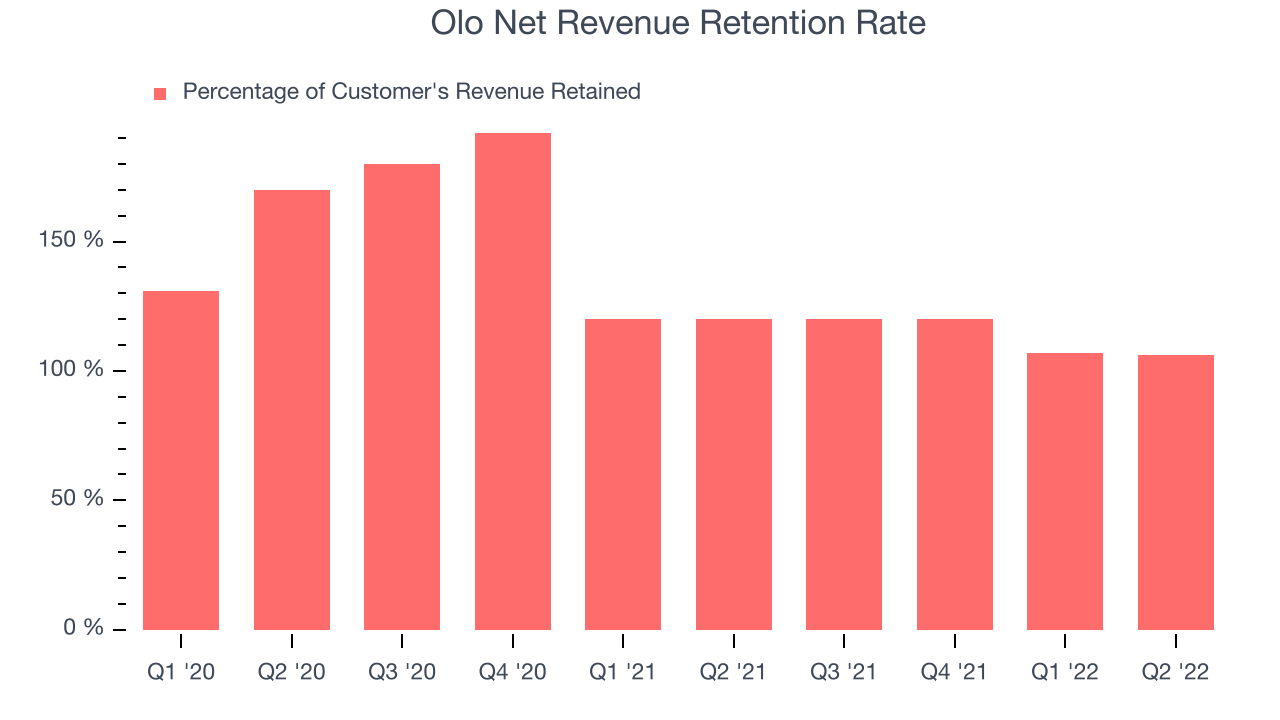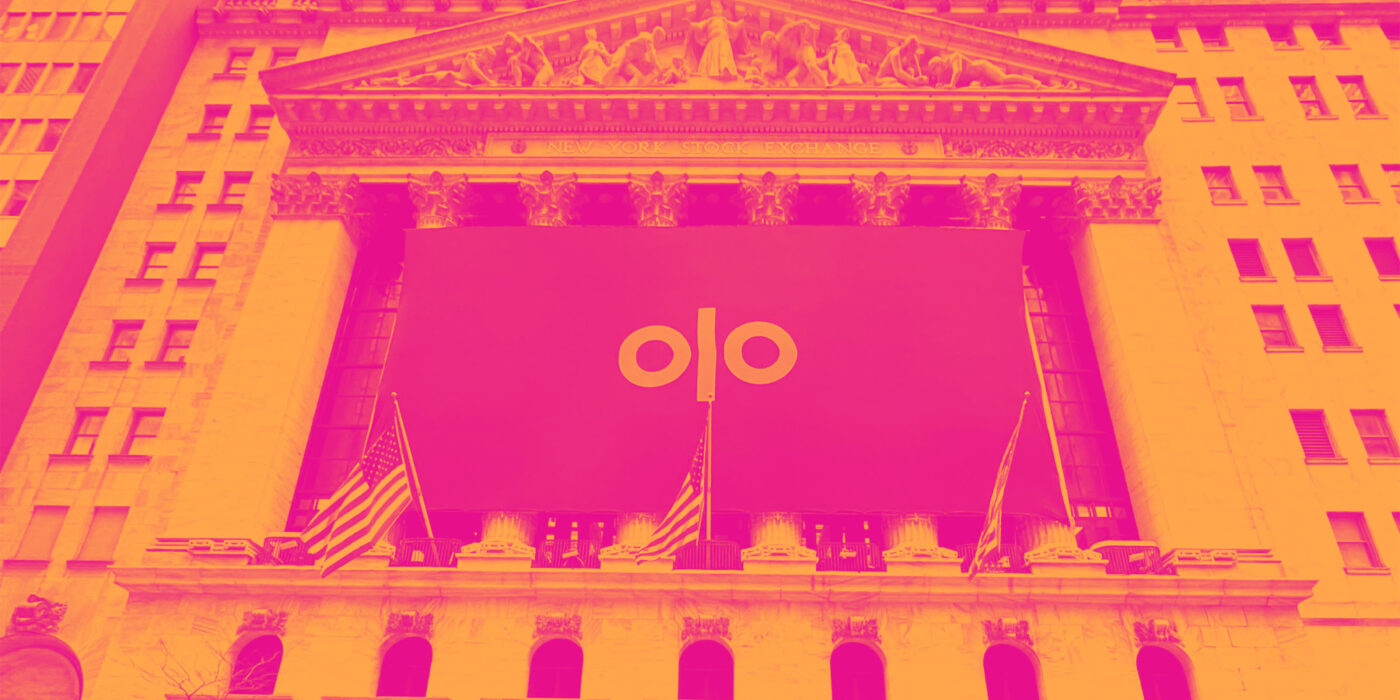Restaurant software company (NYSE:OLO) missed analyst expectations in Q2 FY2022 quarter, with revenue up 27% year on year to $45.6 million. Guidance for the next quarter also missed analyst expectations with revenues guided to $46.7 million at the midpoint, or 8.62% below analyst estimates. Olo made a GAAP loss of $11.6 million, down on its loss of $2.43 million, in the same quarter last year.
Is now the time to buy Olo? Access our full analysis of the earnings results here, it's free.
Olo (OLO) Q2 FY2022 Highlights:
- Revenue: $45.6 million vs analyst estimates of $45.8 million (0.5% miss)
- EPS (non-GAAP): $0.01 vs analyst estimates of $0 ($0.01 beat)
- Revenue guidance for Q3 2022 is $46.7 million at the midpoint, below analyst estimates of $51.1 million
- The company dropped revenue guidance for the full year, from $196 million to $183.5 million at the midpoint, a 6.37% decrease
- Free cash flow was negative $2.97 million, compared to negative free cash flow of $3.42 million in previous quarter
- Net Revenue Retention Rate: 106%, in line with previous quarter
- Gross Margin (GAAP): 68.9%, down from 79.4% same quarter last year
“We delivered solid second quarter results. We generated $45.6 million in total revenue, a 27% increase year-over-year, as our platform supported continued growth in new brands, increased module adoption within our existing customer base, and increased transaction volume,” said Noah Glass, Olo’s Founder and CEO.
Founded by Noah Glass, who wanted to get a cup of coffee faster on his way to work, Olo (NYSE:OLO) provides restaurants and food retailers with software to manage food orders and delivery.
Enterprise resource planning (ERP) and customer relationship management (CRM) are two of the largest software categories dominated by the likes of Microsoft, Oracle, and Salesforce.com. Today, the secular trend of mass customization is driving vertical software that customizes ERP and CRM functions for specific industry requirements. Restaurants are a prime example where a set of customized software providers have sprung up in recent years to create unique operating systems that blend tax and accounting software, order management and delivery, along with supply chain management.
Sales Growth
As you can see below, Olo's revenue growth has been strong over the last year, growing from quarterly revenue of $35.8 million, to $45.6 million.

Even though Olo fell short of revenue estimates, its quarterly revenue growth was still up a very solid 27% year on year. Quarter on quarter the revenue increased by $2.84 million in Q2, which was in line with Q1 2022. This steady quarter-on-quarter growth shows the company is able to maintain its steady growth trajectory.
Guidance for the next quarter indicates Olo is expecting revenue to grow 25% year on year to $46.7 million, slowing down from the 35.9% year-over-year increase in revenue the company had recorded in the same quarter last year. Ahead of the earnings results the analysts covering the company were estimating sales to grow 34.8% over the next twelve months.
In volatile times like these we look for robust businesses with strong pricing power. Unknown to most investors, this company is one of the highest-quality software companies in the world, and their software products have been the default standard in critical industries for decades. The result is an impressive business that is up an incredible 18,152% since the IPO. You can find it on our platform for free.
Product Success
One of the best things about software as a service businesses (and a reason why they trade at such high multiples) is that customers tend to spend more with the company over time.

Olo's net revenue retention rate, an important measure of how much customers from a year ago were spending at the end of the quarter, was at 106% in Q2. That means even if they didn't win any new customers, Olo would have grown its revenue 6% year on year. Despite it going down over the last year this is still a decent retention rate and it shows us that not only Olo's customers stick around but at least some of them get increasing value from its software over time.
Key Takeaways from Olo's Q2 Results
Since it has still been burning cash over the last twelve months it is worth keeping an eye on Olo’s balance sheet, but we note that with a market capitalization of $2.11 billion and more than $460.2 million in cash, the company has the capacity to continue to prioritise growth over profitability.
Olo delivered solid revenue growth this quarter. That feature of these results really stood out as a positive. On the other hand, it was unfortunate to see that Olo's revenue guidance for the full year missed analysts' expectations and that gross margin dropped. Overall, this quarter's results could have been better. The company is down 10% on the results and currently trades at $11.72 per share.
Olo may have had a tough quarter, but does that actually create an opportunity to invest right now? It is important that you take into account its valuation and business qualities, as well as what happened in the latest quarter. We look at that in our actionable report which you can read here, it's free.
One way to find opportunities in the market is to watch for generational shifts in the economy. Almost every company is slowly finding itself becoming a technology company and facing cybersecurity risks and as a result, the demand for cloud-native cybersecurity is skyrocketing. This company is leading a massive technological shift in the industry and with revenue growth of 70% year on year and best-in-class SaaS metrics it should definitely be on your radar.
The author has no position in any of the stocks mentioned.
